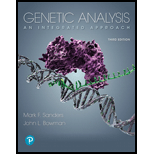
Section
How would this mutation affect attenuation of the tryptophan operon? Explain your answer.
Would formation of the
Trending nowThis is a popular solution!

Chapter 12 Solutions
Pearson eText Genetic Analysis: An Integrated Approach -- Instant Access (Pearson+)
- Is the Aminoacyl tRNA synthetases in human cells specialized or non specialized? Explain.arrow_forwardExamine the tRNA in Figure 15.14. What do you think would be the potential effect of a mutation in the part of the tRNA gene that encodes (a) the acceptor stem; (b) the anticodon; (c) one of the red nucleotide positions?arrow_forwardDNA in human mitochondria encodes 22 different tRNA molecules. However, 32 different tRNA molecules are required for translation of proteins within mitochondria. Explain.arrow_forward
- Many clinically relevant mitochondrial diseases are caused by mutations in mitochondrial genes affecting tRNAs. For example, one form of MELAS (mitochondrial myopathy, encephalopathy, lactic acidosis and stroke-like episodes) is caused by a point mutation in the gene encoding the mitochondrial tRNA whose anticodon recognizes the codons 5' UUA and 5' UUG. The mutation makes the aminoacylation of this tRNA inefficient. a. The rate of synthesis of most mitochondrial proteins is either unaffected or slightly decreased in MELAS cells, but one mitochondrial protein called NAD6 is synthesized at only 10% of the normal rate. How is it possible that the translation of this single mitochondrial protein might be affected specifically?arrow_forwardIn this chapter you were introduced to nonsense suppressor mutations in tRNA genes. However, suppressormutations also occur in protein-coding genes. Using thetertiary structure of the β subunit of hemoglobin shownin Figure 9-3(c), explain in structural terms how a mutation could cause the loss of globin protein function. Nowexplain how a mutation at a second site in the same protein could suppress this mutation and lead to a normalor near-normal protein.arrow_forwardThe covalent attachment of an amino acid to a tRNA is an endergonic reaction. In other words, it requires an input of energy for the reaction to proceed. Where does the energy come from to attach amino acids to tRNA molecules?arrow_forward
- Although aminoacyl-tRNA synthetases make few errors, occasionally an error does occur. How can these errors be detected and corrected?arrow_forwardConsider the now dominant variant of the SARS-CoV-2 called the D614G mutation: a) The mutation changes an Aspartate (D, Asp) to a Glycine (G, Gly) at nucleotide position 614 (that’s why it’s called the D614G mutant) in the S1 subunit of the Spike protein. Using only the information above and a codon table, what are the mRNA codon sequences of the 2019-dominant and 2020-dominant Spike proteins? Note the figure above is not needed toanswer the question. Report in 5’ to 3' orientation __________________________________________ b) What type of substitution is this? In your answer, address the following: • The expected substitution in base sequence (e.g., A à C)• If the mutation is synonymous, nonsynonymous, or a frameshift• If the mutation is a transition or a transversion c) The mutation increases infectivity by reducing the stability of the Spike protein such that it can remain in the open conformation more often. The open conformation increases the chances of binding to the host ACE2…arrow_forwardMany blood clotting proteins undergo a post-translational modification in which specific glutamic acid residues (Glu) in the protein are converted to gamma-carboxyglutamic acid residues (Gla). See reaction scheme below. An example is the blood clotting protein Factor IX, which has 12 Glu in its N-terminus converted to Gla. This modification gives Factor IX the ability to bind calcium and phospholipid membranes. Bacteria do not have the enzyme required to convert Glu to Gla and therefore Factor IX proteins expressed in bacteria would not have the proper modifications. How might you engineer the translational apparatus of a bacterial cell line so that it produces Factor IX with Gla in the appropriate positions. How would you ensure that only the 12 Glu in Factor IX that are normally converted to Gla and not just all Glu (Limit 5-6 senetnces)?arrow_forward
- What is the role of aminoacyl-tRNA synthetase? The ability of aminoacyl-tRNA synthetases to recognize tRNAs has sometimes been called the “second genetic code.” Why has the function of this type of enzyme been described this way?arrow_forwardHow does the cell ensure that a specific amino acid (say, valine) attaches itself only to the one tRNA molecule that is specific for valine? (A) Proteins called aminoacyl DNA synthetases are responsible for bringing together the proper pair. The enzymes match the amino acid and one of the correct DNA molecules carrying the right anticodon. (B) Lipids called aminoacyl tRNA synthetases are responsible for bringing together the proper pair. The lipid binds the amino acid and one of the correct tRNA molecules carrying the right codon. (C) Enzymes called aminoacyl tRNA synthetases are responsible for bringing together the proper pair. The enzymes match the amino acid and one of the correct tRNA molecules carrying the right anticodon. (D) Enzymes called peptidyl mRNA synthetases are responsible for bringing together the proper pair. The enzymes match the amino acid and one of the correct mRNA molecules carrying the right anticodon.arrow_forwardWhat naturally found amino acyl tRNA synthetase can be used to attach 2-aminobutyric acid to a tRNA? Explain whyarrow_forward
 Biology Today and Tomorrow without Physiology (Mi...BiologyISBN:9781305117396Author:Cecie Starr, Christine Evers, Lisa StarrPublisher:Cengage Learning
Biology Today and Tomorrow without Physiology (Mi...BiologyISBN:9781305117396Author:Cecie Starr, Christine Evers, Lisa StarrPublisher:Cengage Learning
